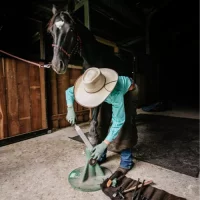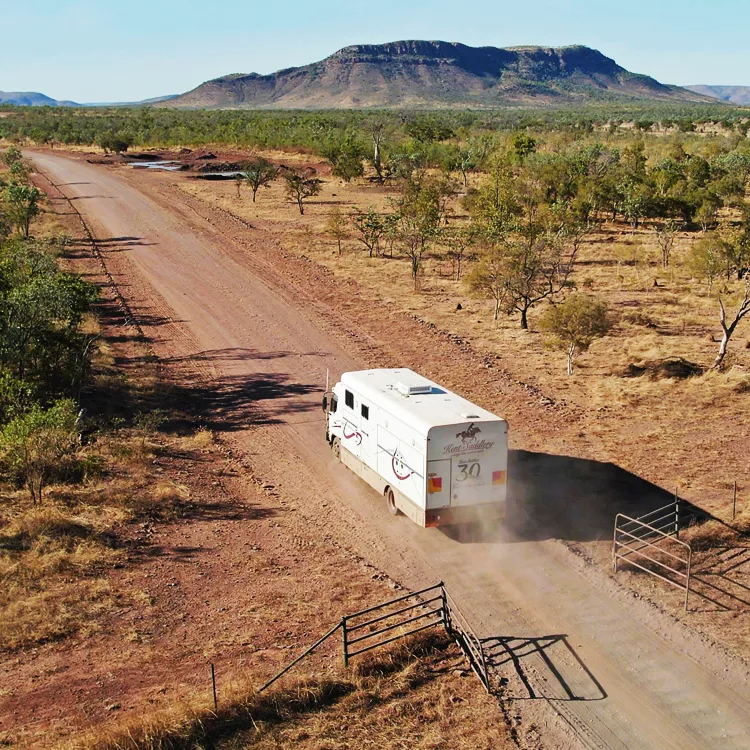Merv Wortley Snr – An Outback Life
In the early 1950’s, at the age of 14, Merv ran away from home and spent 4 years working at Keeroongooloo Station, South of Windorah. Merv pronounces it, “Kurungula” – like no one else can.
Merv has been around horses and cattle all his life, and his youth encompassed a time when ‘Bronco Branding’ was used to brand calves.
He remembers a big black horse named ‘Pig’, and other strong bronco horses which, along with a skilled catcher, made the work easy. Merv records this story of when he was a headstrong youngster. The headstockman had put Merv on a bronco horse to rope calves for branding. Merv wasn’t paying much attention, and his catching rope kept missing the calves. The headstockman warned, “Make sure you catch the next calf.” He missed the calf, and the next thing he was dragged from his horse, a bronco rope attached to another horse tight around him. He hit the ground and was pulled up to the bronco panel.
The other men put leg ropes on him, bronco style, and scruffed him to the ground like they would a strong calf, As the castrating knife appeared, the cheeky kid was “singing out for mercy!” Thankfully, mercy was shown, and he adds, “I never went through that deal again. I made sure I caught the next calf, and I thought “ ____ I’d better do what I’m told!”
The headstockman had the last word, one that Merv wouldn’t forget: “That wasn’t very hard was it?”
Following a suggestion from the manager at Keeroongooloo to “see how other places do it”, Merv joined a droving team and spent several years transferring cattle from Charleville, QLD to Moree NSW. Each drove took 16 weeks, followed by a journey of 16 days to bring the horses back. As he waited for the next mob, he worked on Boatman Station, out of Charleville. Merv married Lois Johnstone in 1965, and they returned to Keeroongooloo where he ran the stockcamp for 25 years.
The stockcamps often had between 20 to 30 men and around 500 working horses, and the ways in which young men were recruited were questionable to say the least. Merv, one time, was at Eromonga waiting to catch the mail truck out to Keeroongooloo, when his swag and saddle were aken and hidden, in an effort to keep him at a nearby station, where 160,000 sheep needed shearing!
He flatly refused to stay and stubbornly let them know, “Well, I don’t care, I’m not stopping here to work sheep!” He travelled on to Keeroongooloo without his swag and saddle, which were sent on to him the following week.
Alternatively, young workers were shouted too many drinks at a local pub, and they’d wake up the next morning on a drove or another work place. “That used to go on a lot,” said Merv.
Merv’s dad was killed on the Kakoda trail during the 2nd World War and, as he tells the tories of his childhood, it’s not difficult to imagine the tough and wiley little boy.
He recalls collecting “dead wool”; trotting along in a horse drawn sulky, he’d notice where sheep had perished in paddocks near the road. He was sometimes aware that property owners would be watching him – “with binoculars, through their windows, so if I’d see a dead sheep, I’d get down off the sulky, pull off a branch from a tree or bush, and make out I was giving my dog a hiding! That poor little dog, wondering what was going on, but then I’d chuck that branch on the roadside near the dead sheep and get back on the sulky, and go along. When it was dark, I’d go back, find that branch, and get through the fence and collect the dead wool. It was worth a £ for a pound, and it may have been the wrong thing to do, but why let it rot away into the ground when somebody could make a few bob out of it, eh?”
During the telling of these life stories, Merv pauses, and asks “In all your travels, have you ever seen that Min Min Light?” As we answer, “No” he quickly responds, “I’ve seen a mob of ‘em!”
Merv first encounted the mysterious light as a kid, when he and his younger sister were out setting rabbit traps. They could see the lights of the station, and when they saw a bobbing light coming towards them, decided it must be the station owner carrying a lantern. Putting out their own light, they sat quietly with their dog in the long grass. Watching through the grass, they saw the light begin to circle around them, at a distance, then going out and appearing behind them, and then somewhere else. Merv adds “That’s where the hair stands up! It’s like “he” (the light) is studying you, looking at you! Another strange thing, that little dog took no notice of the light, and I’ve never known horses or dogs that took any notice.”
He tells of roo shooters, armed with quick action shot guns, with high powered scopes, who on horseback, fearlessly charged the light, firing well aimed shots, only to have it “look at them,” as Merv puts it, and then vanish and appear in another place.
A close relative (younger, and very similar!) first saw the Min Min light while bringing in horses in the dark very early one morning. Forgetting all else, this young ringer galloped all the horses, some hobbled, back to the station, where he received a kick in the backside from the manager and the verbal reprimand of “That won’t hurt you!” (The kick or the light, or both?)
A motorbike breakdown at nightfall, a long distance from the station, saw this same relative resigned to spending the night camped near the bike, knowing someone would come to get him in the morning.
But, here came the light along the top of the sandhill where he was, and as it came owards him he said to himself, “Well, I’m a goner”, and he just put his arms and legs around that motorbike and hung on, promising that Min Min light, “Well, if you’re gonna take me, you’re gonna take the bike too!”
The light went around a couple of times, went down onto the flat, and disappeared, and the bike rider lived to tell the tale.
Merv has experienced rat plagues in the Channels, and caught brumbies for the Indian army. In the 50’s, driving from Quilpie to Windorah on the mail truck at night, it was common to see camp fires about 10 miles apart, knowing that each lot of campfires represented a mob of at least 1000 cattle. He lived alongside immigrants who, following the completion of the Snowy Mountains Hydro Electric Project, came to Keeroongooloo and constructed 100 miles of netting fence. Merv came to Ruby Plains in 1988, and has been there ever since. He reckons it’s been good working at Ruby as head stockman and now as bore runner, and he hopes to retire there and watch his grandchildren grow up. We hope to hear more yarns when we meet with Merv Wortley Snr in 2008. Thanks Merv we appreciate you.
MORE FROM MERV WORTLEY – Read a couple of Merv’s yarns added in Nov 2014 by clicking here.
Image captions:
1) Merv Wortley Snr Ruby Plains 2007
2) Bronco Branding















